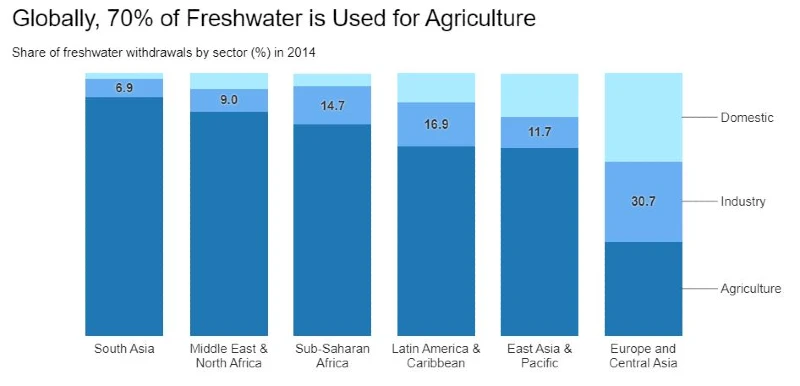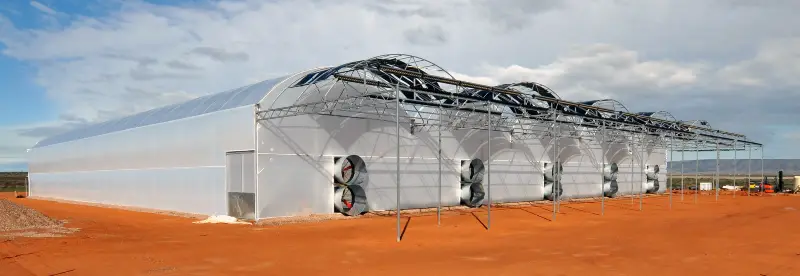Solar-powered seawater greenhouses
It may not seem evident in our daily lives, but the world is rapidly becoming a harsher place to live.
Food production is at risk, and some are starting to look at the ocean for a solution.
If the future of humanity is something you’re interested in, this is an article you can’t afford to miss.
Contents
- Drought is coming
- The potential of the desert
- Desert greenhouses
- Solar desalination
- Concentrated Solar Energy
- Seawater for cooling
- Sundrop Farms
- The Sundrop system
- The hydroponic greenhouse
- The solar system
- Seawater Greenhouses
- External Resources
Drought is coming
Droughts in arid regions are becoming more extreme and less predictable due to climate change, affecting the total water supply available to the public and industry.
At the same time, this water supply is under stress due to human consumption, compounding the pressure on this finite resource.

Neither the amount of water available nor human consumption will change anytime soon, meaning less water will be available.
This water scarcity will primarily affect the agricultural sector as it relies entirely on this freshwater supply.

And this effect is skewed towards arid areas prone to long-term drought, particularly those in developing countries that don’t have the capacity to implement any necessary measures.
For further reading we recommend our article on the water footprint of our everyday lives.
The potential of the desert
Considering this proneness to drought, arid regions are complicated places to launch an agricultural endeavour.
Some arid regions like Israel do agriculture out of an existential necessity, while the Peruvian desert valleys are beginning to struggle with brackish groundwater.
Yet most arid areas have a key ingredient that other more favourable agricultural regions don’t have: bountiful sunlight.

As an investor in a desertic region, an intuitive plan is to forget about agriculture and deploy a solar farm to produce renewable business energy.
For example, a colossal solar energy project in the Sahara has long been discussed as a potential solution for Europe’s green energy future.
However, the fact is that there may be better ways of adding value to land in arid regions besides producing raw electrons. Something that would also bring benefit to local communities through agriculture.
Desert greenhouses
Greenhouses are a water-efficient method of agriculture in arid regions.
You may have heard of the greenhouses in Southern Spain, which produce many of Europe’s cucumbers, watermelons, eggplants, zucchinis, peaches, peppers and tomatoes.
Spain is the second largest tomato producer in the EU thanks to these desert greenhouses.

Greenhouses allow plants to receive ample sunlight for photosynthesis while minimising water loss through evaporation as they provide physical barriers for the water to escape.
Yet this is only possible because SOME water is available in the first place, as the greenhouses are located downstream of the Sierra Nevada mountains, a source of ample fresh water.
But what will happen when this water runs out or starts turning brackish? Almeria’s wells are certainly drying up over time despite some government efforts to improve freshwater management.
Solar desalination
Another source of water that still remains mostly untapped is the ocean, which contains a virtually infinite amount of freshwater.
Many arid regions with agriculture, like the Atacama desert in South America and the Namibian desert in Africa, are ironically coastal deserts.
They have direct access to seawater (or brackish groundwater), which can be turned into distilled water through desalination to water plants.
The issue is that modern industrial-scale desalination is an energy-intensive process that has recently required fossil fuels for electricity.

As the world seeks to decarbonise, fossil fuels are being replaced by solar farms that can leverage the abundant sunlight of arid regions for carbon-neutral desalination.
A large deployment of solar photovoltaics often comes to mind, being the cheap and versatile portable solar alternative to produce the electricity required for standard desalination processes such as Reverse Osmosis.
This is a valid hypothesis, yet there is another way of using solar energy for desalination. Using the sun’s ability to produce heat instead of its ability to excite electrons.
Concentrated Solar Energy
Concentrated thermal solar uses a vast array of mirrors to focus sunlight into a single point, concentrating the energy to produce thousands of degrees of heat, not electricity.
This heat can be used to heat a large distillation still filled with salt of brackish water in a process regularly referred to as solar thermal desalination, which is much simpler than Reverse Osmosis and doesn’t require a complex electrical system.
The only potential issue is that without electricity, it is difficult to run any temperature regulation equipment needed in the desert as the significant temperature variations can easily kill most crops, except that this has a very easy fix.
Seawater for cooling
Like any water, salt water can regulate the ambient temperature simply by existing. Ancient Arab cultures have used water for hundreds of years, circulating it in canals within buildings to keep them cool during the day and warm during the night.
Sub-tropical deserts can have some of the most extreme climates on Earth, with very hot temperatures during the day that descend into freezing at night.
In an agricultural context, this spells certain death for most crops unless this simple trick is leveraged without the need for any complex technology.
Sundrop Farms
Using the seemingly unrelated components we have introduced (i.e. concentrated solar, greenhouses, seawater, thermal desalination), a seemingly unusable arid plot next to the sea was turned into one of Australia’s horticulture powerhouses.
Sundrop Farms in Port Augusta (South Australia) finished their 20-hectare seawater greenhouse facility in 2016 and consistently provided 15% of Australia’s national tomato production =, without the need for fossil fuels.
Not only does the area receive more solar energy than anywhere in Europe and has an infinite seawater resource, but it is located within reach of most of the Australian consumers concentrated on the South West coast of Australia.

The Sundrop System
The facility has a unique system of doing seawater agriculture, with the concentrated solar infrastructure being at the core of all processes (except the cooling of the greenhouse by the seawater).

Flowchart of the Sundrop system of growing crops in a coastal desert. (Credit: Sundrop Farms)
The hydroponic greenhouse

The farm can produce 16,000 tons of tomatoes year-round without requiring genetically modified varieties because of the facility’s saltwater temperature regulation capabilities and ubiquitous sunlight.
Additionally, the greenhouse acts as a physical barrier to pests and diseases that could ravage the entirety of the crop (as it is typical of monoculture), which prevents this from being an issue.
The system requires no soil as it is entirely hydroponic. In other words, it adds nutrients to distilled seawater, which can be endlessly re-utilised in a close, efficient system.
The solar system

As many as 24,000 automated mirrors (heliostats) re-orient themselves throughout the day to point sunlight at the tower’s 127m-high receiver, producing 20,000 MWh of heat to drive thermal desalination.
The Solar Thermal Distillation (STD) system can desalinate 1,000,000 litres of water daily, enough to fill an Olympic swimming pool every three days.
Any leftover heat is used to run a steam turbine that produces 1,700 MWh of electricity per year, enough to power the facility. For reference, it is equivalent to producing power for nearly 200 typical U.S. homes yearly. This use of excess generation acts as a direct alternative to purchasing power from a business energy supplier and paying expensive commercial electricity rates.
Seawater Greenhouses

Sundrop Farm is the first seawater horticulture project operating at a commercial scale. This is a big deal, as new concepts often don’t make it past the prototype stage, and doing so for 6 years proves that seawater horticulture is a financially viable business.
Other similar projects by Seawater Greenhouse Ltd (which was initially involved in Sundrop Farms) have been operating at a small scale since the 1990s in Tenerife, UAE, Oman, Somalia and other coastal arid locations.
The most notorious is the Sahara Forest Project, regularly featured in the COP conferences as the future of clean agriculture for areas with a high risk of extreme drought.
Their pilot project in Jordan has been in development for years, making it frustratingly obvious how slow development is when there is no clear commercial incentive to get it done.
However, it is reassuring to know that these developments in agriculture using clean energy and an infinite water resource are possible, as we will likely need them very soon.
External Resources
- Sundrop Farms
- Mike Hudema
- power-technology
- Aalborg CSP
- Global Solar Atlas
- Sahara Forest Project
- World Bank – Freshwater and Agriculture
- Ourworldindata.org – water stress
- European Commission
- Pacific Institute
- Wikipedia – Concentrated thermal solar
- DK
- Researchgate
- Seawater Greenhouse Ltd
- COP – UNFCCC
- Columbia University
Extended reading:
Agrivoltaic Solar Farms: Find out what Agrivoltaic solar farms are, what their origins are, what the different types are and much more.
Solar Roof Tiles: Find out all about the new technology of solar roof tiles, what they are, how they work and the pros and cons.
Space Based Solar Power: Learn all about space based solar power, who invented it, the advantages and the uses for space based solar power.
Solar Water Heating: Find out what solar water heating is, why it is important, and why Solariskit differs from prior solutions.

